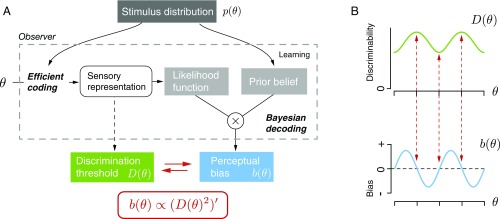Fig. 2.
Observer model that links perceptual bias and discrimination threshold. (A) Our theory of perception proposes that encoding and decoding are both optimized for a given stimulus distribution (4). Based on this theory, the encoding accuracy characterized by Fisher information and the bias of the Bayesian decoder are both dependent on the stimulus distribution . With Fisher information providing a lower bound on discriminability (5, 6), we can mathematically formulate the relation between perceptual bias and discrimination threshold as . (B) Arbitrarily chosen example highlighting the characteristics of the relation: Bias is zero at the extrema of the discrimination threshold (red arrows) and largest for stimulus values where the threshold changes most rapidly. Thus, the magnitude of perceptual bias typically does not covary with the magnitude of the discrimination threshold.

